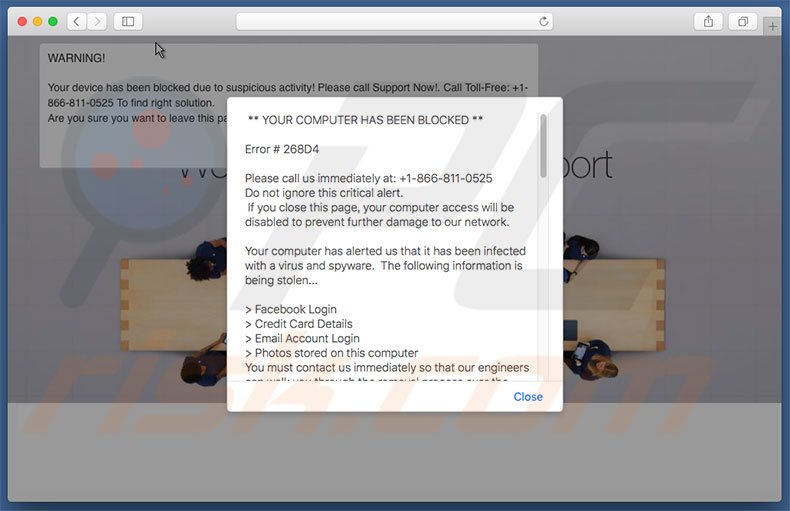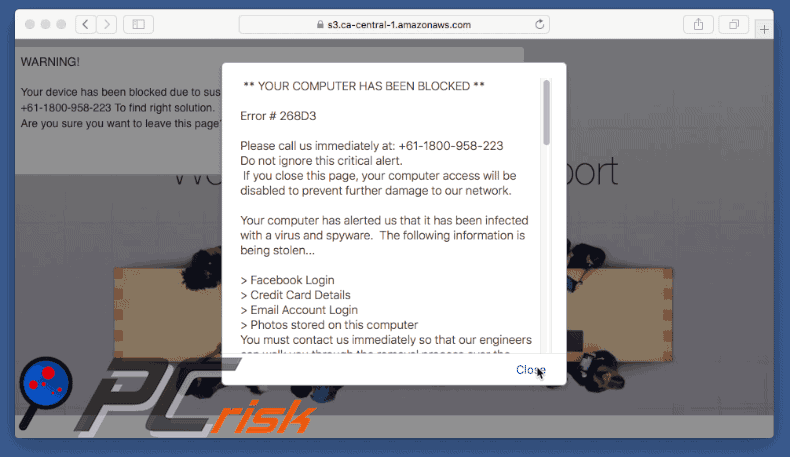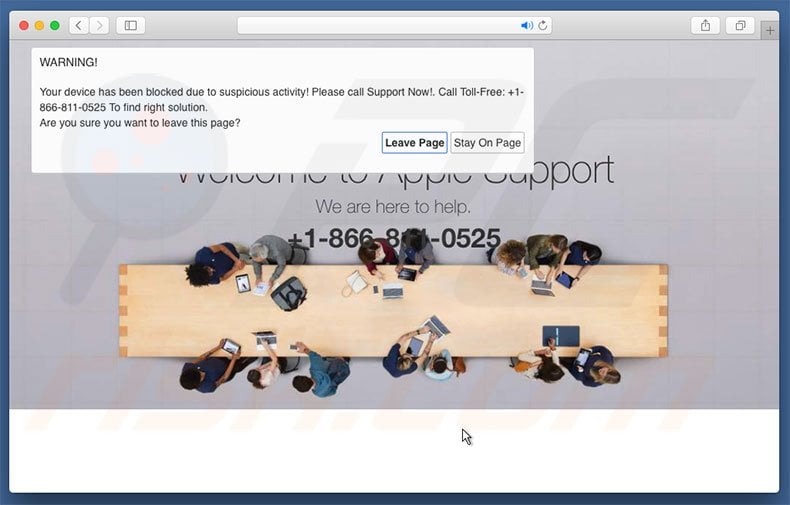Your Device Has Been Blocked Scam (Mac)
Mac VirusAlso Known As: "Your Device Has Been Blocked" virus
Get free scan and check if your device is infected.
Remove it nowTo use full-featured product, you have to purchase a license for Combo Cleaner. Seven days free trial available. Combo Cleaner is owned and operated by RCS LT, the parent company of PCRisk.com.
What is Your Device Has Been Blocked?
"Your Device Has Been Blocked" is a fake pop-up error message displayed by malicious websites. Note that it only targets the Mac OS. Users often visit these malicious websites inadvertently, without their consent - they are redirected by various potentially unwanted programs (PUPs).
These apps usually infiltrate systems without permission ("bundling" method). As well as causing unwanted redirects, PUPs also deliver intrusive online advertisements and gather various information relating to users' Internet browsing activity.

This error message states that suspicious activity has been detected and that personal details (banking information, logins/passwords, etc.) are at risk. It states that, as a result, the system has been blocked. This same message is also played via the computer speakers.
To remove this malware, victims are encouraged to contact certified technicians via a telephone number ("+1-866-811-0525", "+44-800-090-3856") provided. They will then supposedly receive help in solving this issue. Be aware, however, that "Your Device Has Been Blocked" is a scam.
This fake message is merely an attempt to scare and trick victims into calling and paying for technical services that are not required. Cyber criminals generate revenue by tricking unsuspecting users. Therefore, never attempt to contact these people. You can remove this error simply by closing the web browser.
As mentioned above, PUPs also deliver intrusive online advertisements - developers employ a "virtual layer" (a tool that enables placement of third party graphical content on any site). The displayed ads (pop-ups, coupons, banners, etc) often conceal underlying website content, significantly diminishing the web browsing experience.
In addition, the ads often redirect to malicious websites and even accidental clicks can result in high-risk computer infections. Furthermore, potentially unwanted programs track Internet browsing activity by collecting IP addresses, search queries, URLs visited, pages viewed, geo-locations, mouse/keyboard activity, and other similar information.
The data might contain personally identifiable details that developers share with cooperating third parties (potentially, cyber criminals) who misuse private details to generate revenue. Therefore, data tracking can result in serious privacy issues or even identity theft. All PUPs must be uninstalled immediately.
There are many fake errors similar to "Your Device Has Been Blocked". The list of examples includes (but is not limited to) Critical Security Warning!, YOUR APPLE COMPUTER HAS BEEN LOCKED, and Immediately Call Apple Support.
All claim that system is damaged in certain way, however, as with "Your Device Has Been Blocked", these pop-ups are also designed to trick users and, thus, they should never be trusted. Potentially unwanted programs are designed only to generate revenue for the developers.
By delivering promises to enhance the web browsing experience, they attempt to give the impression of legitimacy, however, rather than providing any value for regular users, PUPs cause unwanted redirects, deliver intrusive ads, and continually record personal data.
How did potentially unwanted programs install on my computer?
Criminals proliferate potentially unwanted programs by employing a deceptive marketing method called "bundling" (stealth installation of third party apps with regular software/apps). Criminals hide bundled programs within the "Custom/Advanced" settings of the download/installation processes.
Rushing these procedures and skipping steps often leads to inadvertent installation of potentially unwanted programs.
Here's how this scam looks like (GIF):

How to avoid installation of potentially unwanted applications?
PUPs are distributed using the "bundling" method. Therefore, never rush the download or installation processes. Closely analyze each step within the "Custom/Advanced" settings. Furthermore, decline offers to download/install additional applications and cancel those already included. The key to computer safety is caution.
Text presented within "Your Device Has Been Blocked" pop-up (first variant):
** YOUR COMPUTER HAS BEEN BLOCKED **
Error # 268D4
Please call us immediately at: +1-866-811-0525 or +44-800-090-3856
Do not ignore this critical alert.
If you close this page, your computer access will be disabled to prevent further damage to our network.
Your computer has alerted us that it has been infected with a virus and spyware. The following information is being stolen...
> Facebook Login
> Credit Card Details
> Email Account Login
> Photos stored on this computer
You must contact us immediately so that our engineers can walk you through the removal process over the phone. Please call us within the next 5 minutes to prevent your computer from being disabled.
Toll Free: +1-866-811-0525 or +44-800-090-3856
Second variant of Your Device Has Been Blocked pop-up:

Text presented within "Your Device Has Been Blocked" pop-up (second variant):
Welcome to Apple Support
We are here to help +1-866-811-0525 or +44-800-090-3856
WARNING! Your device has been blocked due to suspicious activity! Please call Support Now! Call Toll-Free: +1-866-811-0525 To find right solution.
Instant automatic malware removal:
Manual threat removal might be a lengthy and complicated process that requires advanced IT skills. Combo Cleaner is a professional automatic malware removal tool that is recommended to get rid of malware. Download it by clicking the button below:
DOWNLOAD Combo CleanerBy downloading any software listed on this website you agree to our Privacy Policy and Terms of Use. To use full-featured product, you have to purchase a license for Combo Cleaner. 7 days free trial available. Combo Cleaner is owned and operated by RCS LT, the parent company of PCRisk.com.
Quick menu:
- What is Your Device Has Been Blocked?
- STEP 1. Remove adware related files and folders from OSX.
- STEP 2. Remove adware from Safari.
- STEP 3. Remove deceptive add-ons from Google Chrome.
- STEP 4. Remove rogue extensions from Mozilla Firefox.
Video showing how to remove adware and browser hijackers from a Mac computer:
Adware removal:
Remove Your Device Has Been Blocked-related potentially unwanted applications from your "Applications" folder:

Click the Finder icon. In the Finder window, select “Applications”. In the applications folder, look for “MPlayerX”,“NicePlayer”, or other suspicious applications and drag them to the Trash. After removing the potentially unwanted application(s) that cause online ads, scan your Mac for any remaining unwanted components.
DOWNLOAD remover for malware infections
Combo Cleaner checks if your computer is infected with malware. To use full-featured product, you have to purchase a license for Combo Cleaner. 7 days free trial available. Combo Cleaner is owned and operated by RCS LT, the parent company of PCRisk.com.
Remove adware-related files and folders

Click the Finder icon, from the menu bar. Choose Go, and click Go to Folder...
 Check for adware generated files in the /Library/LaunchAgents/ folder:
Check for adware generated files in the /Library/LaunchAgents/ folder:

In the Go to Folder... bar, type: /Library/LaunchAgents/

In the "LaunchAgents" folder, look for any recently-added suspicious files and move them to the Trash. Examples of files generated by adware - "installmac.AppRemoval.plist", "myppes.download.plist", "mykotlerino.ltvbit.plist", "kuklorest.update.plist", etc. Adware commonly installs several files with the exact same string.
 Check for adware generated files in the ~/Library/Application Support/ folder:
Check for adware generated files in the ~/Library/Application Support/ folder:

In the Go to Folder... bar, type: ~/Library/Application Support/

In the "Application Support" folder, look for any recently-added suspicious folders. For example, "MplayerX" or "NicePlayer", and move these folders to the Trash.
 Check for adware generated files in the ~/Library/LaunchAgents/ folder:
Check for adware generated files in the ~/Library/LaunchAgents/ folder:

In the Go to Folder... bar, type: ~/Library/LaunchAgents/

In the "LaunchAgents" folder, look for any recently-added suspicious files and move them to the Trash. Examples of files generated by adware - "installmac.AppRemoval.plist", "myppes.download.plist", "mykotlerino.ltvbit.plist", "kuklorest.update.plist", etc. Adware commonly installs several files with the exact same string.
 Check for adware generated files in the /Library/LaunchDaemons/ folder:
Check for adware generated files in the /Library/LaunchDaemons/ folder:

In the "Go to Folder..." bar, type: /Library/LaunchDaemons/

In the "LaunchDaemons" folder, look for recently-added suspicious files. For example "com.aoudad.net-preferences.plist", "com.myppes.net-preferences.plist", "com.kuklorest.net-preferences.plist", "com.avickUpd.plist", etc., and move them to the Trash.
 Scan your Mac with Combo Cleaner:
Scan your Mac with Combo Cleaner:
If you have followed all the steps correctly, your Mac should be clean of infections. To ensure your system is not infected, run a scan with Combo Cleaner Antivirus. Download it HERE. After downloading the file, double click combocleaner.dmg installer. In the opened window, drag and drop the Combo Cleaner icon on top of the Applications icon. Now open your launchpad and click on the Combo Cleaner icon. Wait until Combo Cleaner updates its virus definition database and click the "Start Combo Scan" button.

Combo Cleaner will scan your Mac for malware infections. If the antivirus scan displays "no threats found" - this means that you can continue with the removal guide; otherwise, it's recommended to remove any found infections before continuing.

After removing files and folders generated by the adware, continue to remove rogue extensions from your Internet browsers.
Remove malicious extensions from Internet browsers
 Remove malicious Safari extensions:
Remove malicious Safari extensions:

Open the Safari browser, from the menu bar, select "Safari" and click "Preferences...".

In the preferences window, select "Extensions" and look for any recently-installed suspicious extensions. When located, click the "Uninstall" button next to it/them. Note that you can safely uninstall all extensions from your Safari browser - none are crucial for regular browser operation.
- If you continue to have problems with browser redirects and unwanted advertisements - Reset Safari.
 Remove malicious extensions from Google Chrome:
Remove malicious extensions from Google Chrome:

Click the Chrome menu icon ![]() (at the top right corner of Google Chrome), select "More Tools" and click "Extensions". Locate all recently-installed suspicious extensions, select these entries and click "Remove".
(at the top right corner of Google Chrome), select "More Tools" and click "Extensions". Locate all recently-installed suspicious extensions, select these entries and click "Remove".

- If you continue to have problems with browser redirects and unwanted advertisements - Reset Google Chrome.
 Remove malicious extensions from Mozilla Firefox:
Remove malicious extensions from Mozilla Firefox:

Click the Firefox menu ![]() (at the top right corner of the main window) and select "Add-ons and themes". Click "Extensions", in the opened window locate all recently-installed suspicious extensions, click on the three dots and then click "Remove".
(at the top right corner of the main window) and select "Add-ons and themes". Click "Extensions", in the opened window locate all recently-installed suspicious extensions, click on the three dots and then click "Remove".

- If you continue to have problems with browser redirects and unwanted advertisements - Reset Mozilla Firefox.
Share:

Tomas Meskauskas
Expert security researcher, professional malware analyst
I am passionate about computer security and technology. I have an experience of over 10 years working in various companies related to computer technical issue solving and Internet security. I have been working as an author and editor for pcrisk.com since 2010. Follow me on Twitter and LinkedIn to stay informed about the latest online security threats.
PCrisk security portal is brought by a company RCS LT.
Joined forces of security researchers help educate computer users about the latest online security threats. More information about the company RCS LT.
Our malware removal guides are free. However, if you want to support us you can send us a donation.
DonatePCrisk security portal is brought by a company RCS LT.
Joined forces of security researchers help educate computer users about the latest online security threats. More information about the company RCS LT.
Our malware removal guides are free. However, if you want to support us you can send us a donation.
Donate
▼ Show Discussion